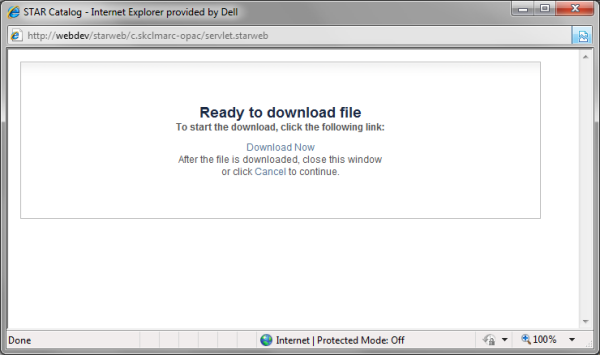See:
| Browse Reports Formats View Selected Full Record Reports Print/Save Download Requests |
After you formulate a search and click Search, you are automatically taken to the Browse report page, with the default report (or the one that you last chose). Browse reports are designed to let you review the results of your search.
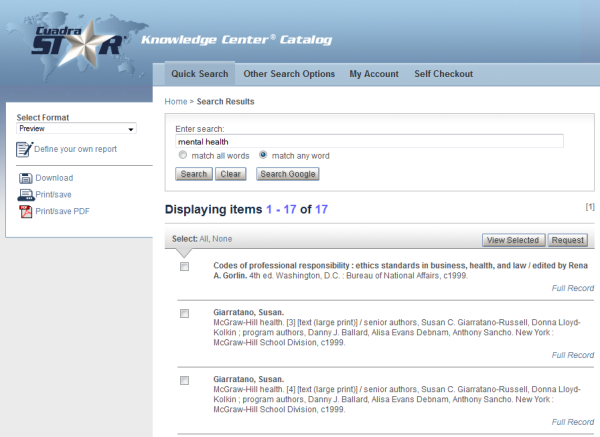
The Browse page contains these elements:
- The Select Format listbox contains a set reports (see) that provide for reviewing the retrieved catalog records in several different sort orders.
-
The "breadcrumb" line under the module tabs tells you where you are and where you came from, e.g., you are on the Search Results page, having entered a Quick Search on the start page (Home). Use these breadcrumbs links to navigate back to a previously used page.
The Browse page reports are always represented by the Search Results link.
-
The Displaying Items line reports the number of retrieved items currently displayed from the total count of retrieved records. To the right of that line are navigation links — [2] [3] ... Next — for moving to the next/subsequent and previous pages
The number of displayed items may be greater than the number of retrieved records if a report has been defined to sort on each occurrence of a repeating field. In repeating field-sorted reports, any given record may be represented more than once in the report.
-
The Select line provides one or two All... links, for having the select checkbox enabled for all retrieved records on the current page or across all pages.
Alternatively, you can make individual selections by checking the Select checkbox for those items. Individual selections will accumulate across subsequently requested pages. The None link is used to remove all selection checks, across all pages.
After making selections, use View Selected to have a new report generated with just the selected records. If you want to refine your selections further, remove the checkbox for any one or several items, and use Refresh to have the report re-generated without the de-selected items. To return to the full results report page, use the Search Results breadcrumb link.
- For all retrieved records or your selected subset, you can choose from among the link options listed on the left — to print/save, download or, if implemented, email a report — or, you can define your own Custom Report.
- To generate a "more data" report for a given record, click the Full Record link.
The set of pre-defined reports is shown below.
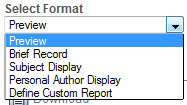
- The Preview report displays records sorted by main entry
Subject Display / Personal Author Display. These two reports sort by data in repeating fields, which means that any given record may be included more than once in the report — for each of the subjects (or authors) in the catalog record.
In the screen capture below, you see that the 17 retrieved records in our search produce a total of 35 items, since titles that have more than one personal name entry are represented multiple times — once for each name.
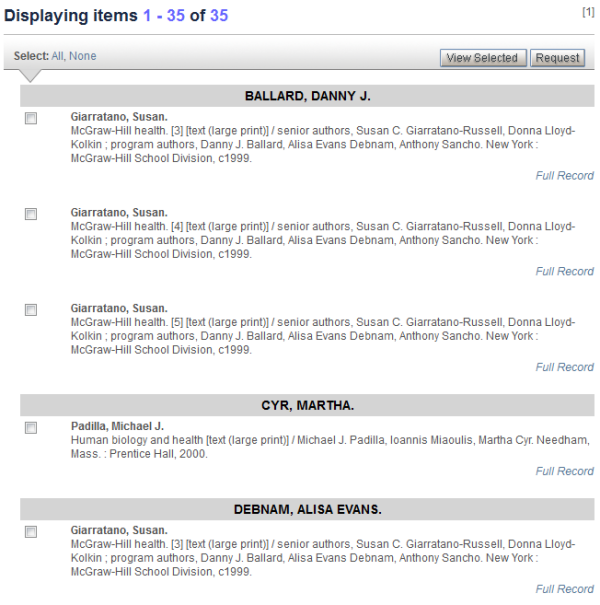
To review selected items of interest in a report, click the checkboxes for those items and use View Selected to have the report regenerated just with those items. If you disable a checkbox, click Refresh to have it regenerated without the removed items.

More reports, for reviewing more detailed information about one or more of your retrieved records, are accessed through the Full Record link associated with each record in a Browse report.
-
On this More report page, you can navigate across retrieved records, using the Previous and Next links to review the set in more detail. The order of records in the More reports mirrors the sort order of your currently selected Browse report.
You can Download or Print/Save just the current record or the set of retrieved records from this More report page.
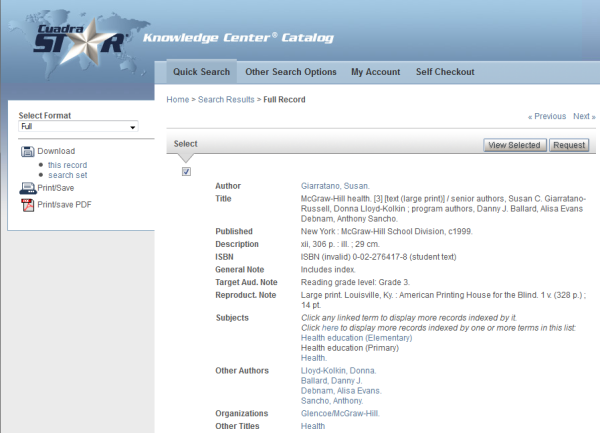
Where you are "now" in the breadcrumb line will be Full Record.
- If you are reviewing several items in more detail to decide which ones to include in a next action (e.g., Print/Save), selections you make will accumulate as you use the Next and Previous options. At any point in this navigation, you can then display all of those selections with View Selected and, in the selected-items report, choose the applicable report-generation option.
- If a record is a "child" to another "parent" record (e.g., if it is an article for which there is a record for the parent journal), click the Show related items in context link to see your item and its parent together, in a single report. Or, if a record is a "parent," click the link to display it with all of its children (e.g., article) records.
The Print/Save links available on both the Browse and More report pages allow you to generate a printer-friendly version of the current report—one without the current HTML page elements — or a PDF.
When you click the Print/save link, a preview report is generated in a popup window.
- To submit the current report to your local or network printer, use the toolbar or File menu Print option.
- To save the current report in a local file, use the Save As File menu option.
When you click the Print/save PDF link, the report will be generated in an Adobe Reader window so that you can use any of its menu choices.
Note the following:
- If you have made selections in a Browse report, first use View Selected and then use one of the Print/Save links; otherwise, your report will include your entire retrieved set.
-
In the More reports, first open the Print/Save menus to make a selection:
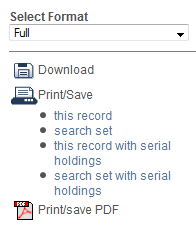
As noted above, the Print/Save option lets you download the current report to your desktop as a text file. The Download link also provides for transferring text data to your desktop, with two differences: the report is a full-record report and the data are generated in a text file with a .dat extension.
When you click the link, a separate popup window, as shown below, is generated with an explanation and a Download Now link used to have that file transferred to your desktop.
